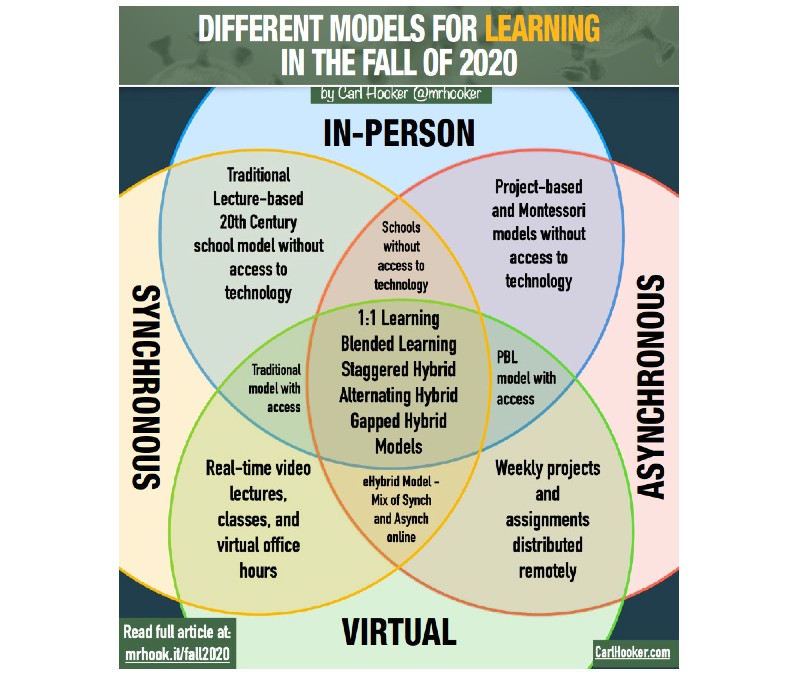New Learning Models for Fall 2020
Schools will be adopting new learning models when students return in Fall

Last spring, the pandemic upended much of what we consider traditional teaching and learning. Educators, students, and parents were forced to triage learning via a variety of online strategies that stretched from handing out digital worksheets to holding class online at the same time every day.
With a little less a month to go before returning to class, many schools are scrambling to develop learning models and plans for how instruction will continue in this “new normal.” Many factors weigh into the creation and execution of these models:
- What type of access to devices and the internet do families in the community have?
- What is the mental and social-emotional state of students, families, and educators?
- How should schools weigh health concerns should the virus hit their campus?
- What does the physical classroom look like with social distancing recommendations?
- What are the expectations around high-stakes testing in this environment?

State and national leadership have done their best to respond to these questions, but many responses have only muddied the waters, with the general message being that “kids need to be in schools.” The American Academy for Pediatrics (AAP) recently added to that pressure by releasing a statement that the AAP “strongly advocates that all policy considerations for the coming school year should start with a goal of having students physically present in school.”
As schools grapple with social distancing requirements that vary from region to region and teachers take crash courses in online teaching, you can see why educational leaders are in full-on crisis mode.
As we push through the heat of the summer, we are getting more examples that returning to school in the “traditional” sense just doesn’t seem feasible. In Texas, there has been a steady increase of positive COVID-19 tests in child care programs, and some schools, such as this one in Florida, have had to shut down after just one week of being open.
With all of this in the back of our minds, educational leaders are trying to come up with different models that both help parents at home and provide enriching learning experiences to students online. Generally, the models for returning to school fall into three main categories: In-Person, Virtual, or a Hybrid version of the two. Within each of these categories are various models in which schools are attempting to achieve some version of student learning.
The following models are not the only examples that exist, but in interviewing more than 30 different school leaders from around the world in the last month, seem to be most common.
Tools and ideas to transform education. Sign up below.
In-Person School
The most traditional version of learning involves having students back in the school building in some form or fashion. Schools that are attempting this are implementing a variety of social distancing recommendations: face masks, reduced class sizes, and limited movement during passing periods. Students would remain in cohorts or small teams throughout the day, and should one group be infected, that cohort and anyone associated with it (teachers) would be sent home for a period of time.
Generally, the case for in-person school comes from those with younger children, especially in the primary grades, as those students are in key social developmental stages of their life that can’t be mimicked as easily in an online environment. That said, as many as 65% of colleges have recently announced that buildings will be open to in-person learning in Fall.
Pros/Cons of the In-Person School:
This model most closely resembles what school looks like now with some minor changes. Therefore, it wouldn’t require much staff training aside from new social distancing protocols. Having students in schools provides a greater sense of community and belonging as well as an opportunity to develop social skills (albeit at a distance). For parents, this model offers the custodial benefit of having someone physically watch over their kids as they go to work.
The cons include the amount of space needed to make this happen since having 10 to 12 students in a class requires at least twice as many rooms to accommodate everyone. Transportation will also be a challenge as school buses have to operate at reduced capacity. Also, with the lack of movement, students will likely be sitting even more than they would previously. If a cohort is infected and a group is sent home, how long will they be away and how will learning be supplemented for those that miss physical seat time? Also, how will sick leave be handled when a teacher is sent home for 14 days?
One possible solution to the space issue is having secondary students learn online while utilizing their buildings for elementary student in-person learning.
Ideal Demographic for In-Person School:
Rural districts seem to be ideal candidates for the in-person model because there are two strong reasons for students to be in school: A lack of internet connectivity within the community and a low number of COVID-19 cases due to being spread out and away from hot spots.

Virtual School
Rather than even attempting to have students enter and re-enter a building, and untangling the complications of transportation, after care, and enrichment programs, some districts are choosing to go fully virtual and have all classes online to start the school year. Some districts such as Atlanta Public Schools, LA USD, and Fort Bend ISD (outside of Houston) have already announced this in order to prepare their students, parents, and staff.
Three main models can be found in this category, each of which have merits.
Synchronous Online Model
Some schools have tried to keep classes as similar as possible to in-person learning during the sudden shift to online learning. In this model, class schedules mimic traditional schedules, sometimes adjusting to more of an alternating block approach (A day - 4 classes, B day - 4 classes) to spread the amount of direct instruction and screen time. Students “attend” classes by logging into a video conference tool at regularly planned times with breaks in between subjects to avoid screen fatigue.
Pros/Cons of the Synchronous Online Model:
One advantage of this model, beside physical health and safety, is the semblance of an accustomed routine. This model also reduces pressure on parents for teaching and learning support since the teacher takes on that responsibility via video chats. Tracking attendance is easily done simply by seeing which students are online during each session. Having synchronous whole-class meetings online also helps maintain a sense of community and allows for just-in-time support and feedback.
Major disadvantages to this type of learning are the extra amount of screen time and the reliance on increased bandwidth. If a household has multiple students and parents working remotely, basic internet or 4G likely may not be enough to maintain multiple video conferencing streams. Teachers will also need high bandwidth in their homes to provide high-quality video instruction.
This model is also very rigid in terms of schedule. If a student doesn’t learn well at certain times of the day or they aren’t able to log-on, are they counted absent? Recording synchronous sessions to send to students is one way to make sure they don’t miss key instruction should they be experiencing connectivity issues at home.
Asynchronous Online Model
In this model, schools send home weekly work via shared documents, an LMS (Learning Management System), a website, or email. The teacher(s) create these resources in the form of self-guided projects or apps to help address the state standards for each grade level and/or subject area. Students submit work based upon deadlines and have flexibility to adjust their schedule to their own learning preferences (i.e. working at night, morning, etc).
Pros/Cons of the Asynchronous Online Model:
Advantages to asynchronous online learning include flexible time and schedules based on each students’ learning style. This model builds in more time for reflection and doesn’t require intense internet bandwidth or lengthy periods of screen time. Students in this model also have a greater sense of ownership as they can set their own pace when it comes to completing weekly projects and tasks.
Disadvantages to this model is the lack of organization or schedule. Parents who are already under various stresses around work and quarantine now have added pressure to make sure their students are completing assignments in a timely fashion. Having experienced this model first-hand in the spring, I can tell you if you have multiple students in your home, it can consume hours of your day tracking down resources, logins, directions, and expectations from multiple teachers. You also lose any sense of classroom community when all learning is done individually, and tracking attendance in a traditional sense is impossible.
One possible work around for the attendance issue that I’ve seen is a school using a tool such as NetRef’s Classroom Management feature to monitor “time on task” as a way to track student engagement and set thresholds based on age and time spent during the online learning “school day.”
eHybrid Model:
This model features a mix of both synchronous and asynchronous learning. Teachers schedule times throughout the school day and week to check in with students via whole group instruction and virtual office hours, and also send the week’s overview of projects to be completed asynchronously.
Pros/Cons of the eHybrid Model:
This model takes the best parts of synchronous (having a schedule and routine) learning while allowing for the flexibility of asynchronous. One advantage is the limited amount of seat/screen time while still staying connected throughout the day and week. For those who can’t make the synchronous video portions of class, those can be recorded and distributed to students for asynchronous learning. When done correctly, students have some level of ownership over their work while still having multiple opportunities for teacher feedback, either via video chat or email, or through an LMS.
Some cons are similar to those in the other online models: internet bandwidth and connectivity concerns during the synchronous parts of the day (although less of a concern if they are spread out throughout the week), and the pressure on parents to keep students on task during the asynchronous parts. Attendance tracking also can become an issue in this environment as some students might not be able to meet during the scheduled times. The use of virtual office hours to work with small groups and individuals is an important component of this model for its success.
Ideal Demographic for Virtual School:
Urban or highly populated suburban school districts generally are ideal candidates for a fully virtual experience. Being in more populated areas, internet access isn’t as great a problem as rural areas. Plus, COVID-19 outbreaks have been centered around densely populated areas, making in-person schooling much more of a challenge.

Hybrid School
Rather than choosing between online or in-person, some districts are attempting to spread in-person classes and supplement learning with virtual classes, creating a “hybrid” of the two.
Having virtual classes built into learning means that regardless of any new virus outbreak, instruction can continue to take place outside of the school building. Students report to a campus, even part-time, allowing for that sense of community and the bonuses of just-in-time feedback. This also allows for better small-group collaboration in which students can begin a project together in-person and then continue online. Districts such as those in Madison, Washoe County, and Santa Ana Unified School District have already announced plans around a hybrid model, as have many others across the country.
Before we get into the pros and cons of Hybrid schooling, I’ve listed some creative ways that schools are adjusting in-person and virtual schedules.
1:1 Blended Learning Model. School districts with 1:1 devices have been doing a version of blended learning (in which learning is both analog and digital) for years. However, the majority of this learning still takes place within the school building. A blended hybrid model would have some students in class while others are watching from home synchronously. As all students have the same device, instructions can be consistent and troubleshooting technology doesn’t become as big a factor. This model gives parents the option of sending their students to school or keeping them home knowing that in either scenario, they will be on pace with their peers.
Staggered Hybrid Model. In this model, the school day is split in half in order to reduce the number of students in the building. For example, students in group A attend school in the morning and then, following a midday sanitizing break, students in group B attend. While students are participating during the in-person portion of the school day, they are given asynchronous assignments to be completed virtually later.
Gapped Hybrid Model. The issue with the staggered model is allowing for enough time to sanitize the building in between groups. This model splits the week into a “2 on, 3 off, with a gap” scenario. Students in group A attend school in-person on Monday and Tuesday, school is closed for deep sanitizing on Wednesday, and then students from group B have their two days of in-person learning on Thursday and Friday. When not in the building, students complete asynchronous projects and use in-class time to review or preview the work they’ll be doing at home.
Alternating Hybrid Model. Rather than splitting the school day or even week in half, some schools are opting to alternate either days or weeks that students are in schools. In these models, group A attends school every other day in-person, alternating with group B. In some of the more extreme scenarios, schools are splitting their students into three groups and then alternating weeks. In this alternating hybrid model, students from group A attend school for one week and then have 2 weeks of virtual learning while students from groups B and C have their in-person weeks.
Pros/Cons of Hybrid School:
These models, as well as many others that schools are considering under the “hybrid” umbrella, take significant planning and coordination. One of the major benefits of these models is that students get the best of both worlds: The sense of community that comes with in-school learning while families and working parents get breaks throughout their week. Schools are able to fill in the gaps of virtual learning with in-person sessions, and vice versa. Also, should an outbreak occur, these models could switch to full virtual school a little easier than those schools choosing to go completely in-person.
The cons of these models include figuring the logistics of scheduling everything from transportation to meals, to planning the school day. Teachers will be stretched into essentially teaching twice as much throughout the week as they prepare lessons for in-person as well as for virtual learning.
One strategy being discussed in schools is leveraging those teachers who are at-risk and putting them in charge of the virtual component. This would help with the stress of managing both environments simultaneously. The other major con is parents who may not have the flexibility to be at home on alternating days or weeks while the students participate in virtual learning. Parents in these situations (as well as fully virtual) have already taken to their local online community groups to plan “micro-pods” of students who can gather at the home of a stay-at-home parent during the virtual hours.
Ideal demographic for Hybrid School:
Districts in smaller towns or suburban areas that are not densely populated seem to be the sweet spot for this model. Internet connectivity at home cannot be a major issue for this to work, and low local infection rates also have to be present to make the in-person part of the school day manageable.
Summary
Ultimately, there is no “one-size-fits-all” model for the education challenges that schools and communities in this country face. Connectivity, access to devices, family situations, demographics, and COVID-19 outbreaks all play critical parts in the decisions school leaders are making.
One bit of advice to school leaders out there: You don’t have to do this all by yourself. When you create a plan, share that plan with staff in your schools and invite them to “poke holes” in it. This will improve transparency and communication, and give staff a sense of ownership in whatever the final plan is. The truth is, you’ll never come up with a plan that is supported by 100% of your community, but by inviting your team into the process, you can enhance your chances in having success, regardless of whatever model you choose.
Best of luck.
Carl Hooker has been a part of a strong educational shift with technology integration since becoming an educator. As Director of Innovation & Digital Learning at Eanes ISD, he has helped spearhead the LEAP program, which put one-to-one iPads in the hands of all K-12 students in his 8,000-student district. He is also the founder of “iPadpalooza”- a three-day “learning festival” held in Austin annually. He's also the author of the six-book series titled Mobile Learning Mindset, a guide for teachers, administrators, parents and others to support and embrace mobile learning in our schools. Read more at Hooked on Innovation.
Carl Hooker has spent the past 20+ years in education as a teacher and administrator focused on the thoughtful integration of technology and innovation. He consults for multiple districts across the country and is a frequent speaker at state and national events. In his free time he's an author, DJ, podcast host, Poetry Slammer, and Trivia Night MC. He's the co-founder of the social platform K12Leaders.com. Check out his latest book Ready Set FAIL! Now available for order here: https://mrhook.it/fail Read more of his blogs at Hooked on Innovation.
